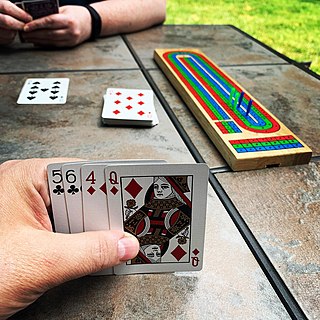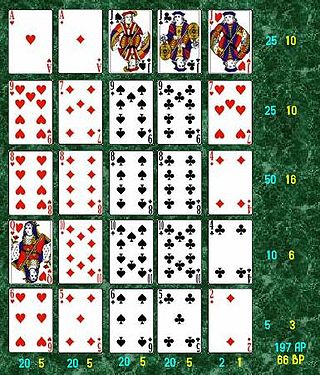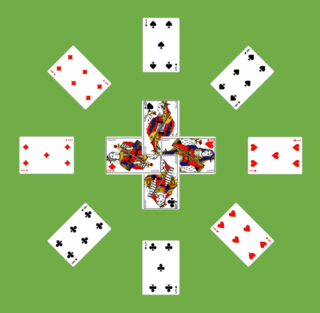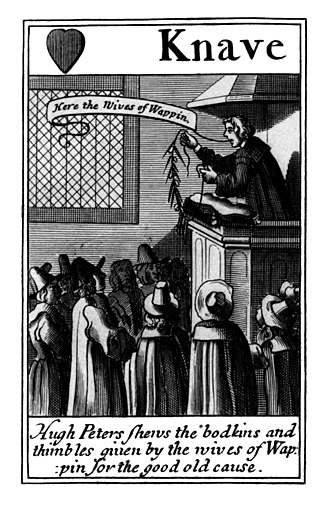
Games of patience, or (card) solitaires as they are usually called in North America, have their own 'language' of specialised terms such as "building down", "packing", "foundations", "talon" and "tableau". Once learnt they are helpful in describing, succinctly and accurately, how the games are played. Patience games are usually for a single player, although a small number have been designed for two and, in rare cases, three or even four players. They are games of skill or chance or a combination of the two. There are three classes of patience grouped by object.

Cribbage, or crib, is a card game, traditionally for two players, that involves playing and grouping cards in combinations which gain points. It can be adapted for three or four players.

Golf is a card game where players try to earn the lowest number of points over the course of nine deals.
Osmosis is a solitaire game played with a deck of 52 playing cards. The object, like many solitaire games, is to put the cards into foundations, although not in numerical order. The name of the game reflects the fact that cards of the same value slowly filter through to successive foundations by osmosis.

Monte Carlo is a pair-matching patience or card solitaire game using a pack of 52 playing cards where the object is to remove pairs from the tableau. Despite its name, it has no relation to the city with the same name nor to any casino-related game. Alternative names for this game include Good Neighbours and Weddings.

Poker Squares is a patience game with the objective of building the best poker hands using just 25 cards from the deck. It rewards both lucky guessing and accurate calculation of odds.

Quadrille is the name of two loosely related card games of the Patience or solitaire type which are often confused. Both use a pack of 52 playing cards. The earlier one was also known as La Française or Royal Quadrille, the slightly later one as Captive Queens. The name is derived from the desired outcome of the earlier game in which the four Kings and Queens are arranged in a square formation as in the European dance of quadrille that was fashionable in the 18th and 19th centuries.
Cribbage solitaire is a solitaire card game using a deck of 52 playing cards. It is based on the game of five-card cribbage, also known as the "old game", and is one of many solitaire card games based on those played by at least two players, best known of which is poker solitaire.
Royal Cotillion is a solitaire card game which uses two decks of 52 playing cards each. The name probably derives from the fact that since the two kings and two queens of the same suit, the king and queen of each suit dance the cotillion. It has been given the alternate name of Lords and Ladies because if the game is won, the final layout will show the king and queen of each suit together.

Crazy Quilt is a patience or solitaire card game using two decks of 52 playing cards each. The game is so-called because the reserve resembles the weaves of a carpet or an arrangement of a quilt, with cards alternating vertical and horizontal rotations.
Napoleon's Square is a patience or solitaire card game which uses two decks of playing cards. First described in a revised edition of Lady Cadogan's Illustrated Games of Patience or Solitaire in the early 1900s, it is an easy variation of Napoleon at St Helena. It is not determined if Napoleon actually played this game, or any solitaire game named after him.

Queen's Audience, sometimes known as King's Audience, is a pictorial patience or solitaire card game which uses a single pack of 52 playing cards. It is so named because the Jacks and their 'entourage' end up adjacent to their respective Queens as if having an audience with them.
Deuces or Twos is a patience or card solitaire game of English origin which is played with two packs of playing cards. It is so called because each foundation starts with a Deuce, or Two. It belongs to a family of card games that includes Busy Aces, which is derived in turn from Napoleon at St Helena.

Fortune's Favor or Fortune's Favour is a patience or card solitaire which is played with a deck of 52 playing cards. It is so-called probably because the chances of winning are completely on the player's side. It is a significantly simplified version of the game Busy Aces, a member of the Forty Thieves family of solitaire games.

Spider Solitaire, also known as Microsoft Spider Solitaire, is a solitaire (NA)/patience (EU) card game that is included in Microsoft Windows. It is a version of Spider. As of 2005, it was the most played game on Windows PCs, surpassing the shorter and less challenging Klondike-based Windows Solitaire.

Noddy also Noddie, Nodde or Knave Noddy, is a 16th-century English card game ancestor of Cribbage. It is the oldest identifiable card game with this gaming structure and thus probably also ancestral to the more-complicated 17th-century game of Costly Colours.
Elevens is a patience or card solitaire of the Simple Addition family that uses a standard 52-card deck, with the goal of removing pairs of cards that add to eleven. Odds of winning are slightly better than 1 in 10.
In cribbage, the probability and maximum and minimum score of each type of hand can be computed.
The rules here are based on those of the American Cribbage Congress and apply to two-, three- or four-player games, with details of variations being listed below.

Costly Colours, sometimes just called Costly, is an historical English card game for two players and a "fascinating relative of Cribbage". The game "requires a moderate amount of skill in playing, and is well adapted to teach quickness in counting". It has more combinations than Cribbage and retains the original scoring system for points, but does not use a 'crib'. In the 19th century it was described as "peculiar to Shropshire."













































